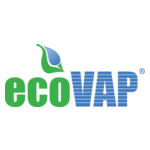EcoVAP Records Highest Evaporation Rate to Date, 63x Pan Rate, at BRGNDRF Test Facility
OREM, Utah–(BUSINESS WIRE)–EcoVAP, Inc. is proud to announce the first results of a pilot-scale EcoVAP Evaporation Matrix at the Brackish Groundwater National Desalination Research Facility (“BGNDRF”) in Alamogordo, New Mexico. The project is being partly financed by the Bureau of Reclamation (“Reclamation”) based on EcoVAP winning a grant to dispose of excess brine water in the lowest cost and most environmentally-friendly way possible.
Results
For the test period (including the end of summer, fall, and the beginning of winter), EcoVAP evaporated water at 63.4x the normal “pan” rate per unit of surface area. In other words, by deploying an EcoVAP Matrix, for every inch of water that mother nature naturally eliminates on a pond surface, EcoVAP eliminated 63.4 inches. This result is slightly greater than the 59x multiple of EcoVAP vs. conventional evaporation recorded by a Golder Associates validation report in 2017.
EcoVAP CEO Jason Mendenhall states that “The Bureau of Reclamation and BGNDRF facilities have been invaluable in our effort to further legitimize EcoVAP’s proven biomimicry-based enhanced evaporation technology. We are pleased with these initial results, and welcome anyone to visit the EcoVAP pilot at BGNDRF or any of our full-scale operating facilities in Montana, Utah, Texas, and California.”
Methodology
BGNDRF provided the ideal test site for EcoVAP’s enhanced evaporation technology in having two side-by-side identical conventional evaporation ponds, each with 16,667 square feet of surface space. Thus, one pond was measured as a “Control” pond while the other was retrofitted with an EcoVAP Matrix. Meters measure the amount of water released in each pond to keep each pond at the same level, thus indicating how much water evaporated out of each pond. To make the Control Pond and EcoVAP Matrix ponds comparable, the EcoVAP Matrix results were grossed up to assume full coverage of the pond, thus providing the relevant comparison of evaporation rate per amount of surface landspace used.
Background on BGNDRF/EcoVAP Project
Reclamation believes that inland desalination of brackish water is an important tool for addressing water scarcity. Reclamation’s Desalination and Water Purification Research (“DWPR”) program invests in technologies that show potential for reducing the costs and environmental impacts of treating impaired waters. This amount of brackish water in underground aquifers greatly dwarfs underground freshwater, much of which has already been tapped out, and desalinating ocean water can only economically serve nearby coastal areas due to transportation costs. The process for desalinating the inland brackish water is similar to desalinating seawater, mainly using reverse osmosis. Nevertheless, inland “BWRO” plants are severely constrained by the challenge of disposing of the residual “concentrated” ultra-briny wastewater that is not desalinated. Whereas seawater desalination plants (“SWRO”) can generally return this concentrate to the ocean, inland brackish concentrate volumes are so large that they cannot be easily disposed of. BWRO concentrate disposal adds up to 1/3 to the total desalination cost, still with environmental challenges, and usually limiting the size and life of the BWRO plant. The United States currently has 1,400 desalination plants, with the majority being the inland brackish water BWRO plants.
In describing their mission and EcoVAP’s results, BGNDRF Facility Manager Malynda Cappelle states “The Brackish Groundwater National Desalination Research Facility (BGNDRF) is a place where companies demonstrate their technologies in a real world application. With funding from Reclamation’s Pitch to Pilot program, EcoVAP has been doing such work here since 2019 and has gathered promising data.”
The BGNDRF Matrix will be operational, open to public visit, for the next year. Over this time, EcoVAP will be further measuring and optimizing the design of the Matrix vs. a much larger swath of weather conditions and wastewater chemistry.
EcoVAP
EcoVAP, Inc. has a proven technology for reducing wastewater volumes (including produced water from oil/gas, mining tailings ponds, other industrial wastewater) using the biomimicry of Mother Nature to evaporate water at >59x the normal “pan” rate. Traditionally, large-scale water desalination/purification could only be achieved by energy-intensive filtration, thermal, chemical, and mechanical processes. EcoVAP’s technology represents a revolutionary shift with a holistic “first principles” approach that mimics nature’s own hydrological process.
EcoVAP can generally reduce wastewater volume by 80-95%, thus allowing for a similar reduction in the footprint for the evaporation ponds, tailings ponds, underground injection and all of the transportation infrastructure (i.e., trucks and pipes) to reach these facilities. The Reclamation grant recognizes EcoVAP’s ability to also reduce BWRO concentrate, likely by >90%, thus significantly improving the competitiveness of inland desalination while reducing the environmental footprint. In contrast to other forms of “dewatering” the concentrate, EcoVAP uses practically no energy, no chemicals, and requires no transportation.
EcoVAP has successfully deployed full-scale commercial Evaporation Matrices in various industrial sectors (oil/gas, power, mining), and believes the same technology will be successful in practically any industry that needs to reduce wastewater volumes, any location (including cold, rainy), and, being fully modular, to meet any disposal size.
Contacts
Kristen Lamb-Reilly
Chief Operating Officer
(801) 960-3238
klamb@ecovap.com


